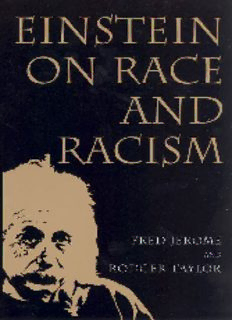
Einstein on Race and Racism PDF
Preview Einstein on Race and Racism
Einstein on Race and Racism Einstein on Race and Racism FRED JEROME AND RODGER TAYLOR Rutgers University Press New Brunswick, New Jersey, and London Disclaimer: Some images in the original version of this book are not available for inclusion in the eBook. Library of Congress Cataloging-in-Publication Data Jerome, Fred. Einstein on race and racism / Fred Jerome and Rodger Taylor. p. cm. Includes bibliographical references and index. ISBN 0–8135–3617–0 (hardcover : alk. paper) 1. Einstein, Albert, 1879–1955—Views on racism. I. Taylor, Rodger, 1953– II. Title. QC16.E5J466 2005 530(cid:1).092—dc22 2004023485 A British Cataloging-in-Publication record for this book is available from the British Library. Copyright © 2005 by Fred Jerome and Rodger Taylor All rights reserved No part of this book may be reproduced or utilized in any form or by any means, electronic or mechanical, or by any information storage and retrieval system, without written permission from the publisher. Please contact Rutgers University Press, 100 Joyce Kilmer Avenue, Piscataway, NJ 08854–8099. The only exception to this prohibition is “fair use” as defined by U.S. copyright law. Manufactured in the United States of America To the people of Witherspoon Street, yesterday and today Contents Preface ix Acknowledgments xi PART I. EINSTEIN AND ROBESON ON WITHERSPOON STREET 1. Escape from Berlin 3 2. “Paradise” 11 3. The Other Princeton 20 4. Witherspoon Street 34 5. Einstein and Robeson, I 50 6. “Wall of Fame” 66 7. The Home Front 76 8. Civil Rights Activist 85 9. From World War to Cold War 98 10. Einstein and Robeson, II 122 11. “My Friend, Doctor Einstein” 129 PART II. DOCUMENTS 1. Einstein’s Statements on Race and Racism 135 A. “To American Negroes,” The Crisis, February 1932 135 B. Address at the Inauguration of the “Wall of Fame” at the World’s Fair in New York, 1940 138 C. “The Negro Question,” Pageant,January 1946 139 D. Speech to Lincoln University [Pennsylvania] Students and Faculty, May 3, 1946 142 vii CONTENTS E. Letter to President Harry S. Truman on Antilynching Law, September 1946 143 F. Message to the National Urban League Convention, September 16, 1946 144 G. On Walter White, October 1947 147 H. Interview with the Cheyney Record, October 1948 148 I. Message to the Southwide Conference on Discrimination in Higher Education, Sponsored by the Southern Conference Educational Fund (SCEF), Atlanta University, 1950 150 J. Interview with Peter A. Bucky 151 K. Letters from W.E.B. Du Bois, 1951 152 2. From Einstein’s FBI File: On Civil Rights 154 Notes 161 Bibliography 185 Index 197 viii Preface More than one hundred biographies and monographs about Albert Einstein have been published, yet not one of them men- tions the name Paul Robeson, let alone Einstein’s friendship with him; or the name W.E.B. Du Bois, let alone Einstein’s sup- port for him. Nor does one find in any of these works any refer- ence to the Civil Rights Congress whose campaigns Einstein actively supported. Finally, nowhere in all the ocean of published Einsteiniana—anthologies, bibliographies, biographies, sum- maries, articles, videotapes, calendars, posters and postcards— will one find even an islet of information about Einstein’s visits and ties to the people in Princeton’s African American commu- nity around the street called Witherspoon.1 One explanation for this historical amnesia is that Einstein’s biographers and others who shape our official memories felt that some of his “controversial” friends, such as Robeson, and activities, such as co-chairing the antilynching campaign, might somehow tarnish Einstein as an American icon. That icon, sanc- tified by Timemagazine when it dubbed Einstein the “Person of the Century,” is a myth, albeit a marvelous myth. In fact, as myths go, Einstein’s is hard to beat. The world’s most brilliant scientist is also a kindly, lovably bumbling, grandfather figure: Professor Genius combined with Dr. Feelgood! Opinion-molders, looking down from their ivory towers, may have concluded that such an appealing icon will help the great unwashed public feel good about science, about history, about America. Why spoil such a beautiful image with stories about racism, or for that mat- ter with any of Einstein’s political activism? Politics, they argue, is ugly, making teeth grind and fists clench, so why splash poli- tics over Einstein’s icon? Why drag a somber rain cloud across a ix
Description: